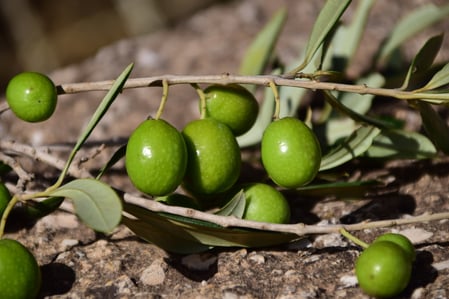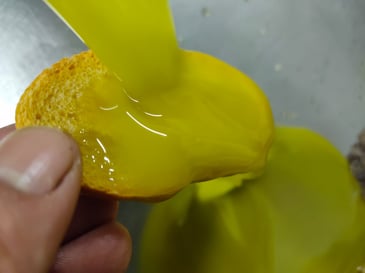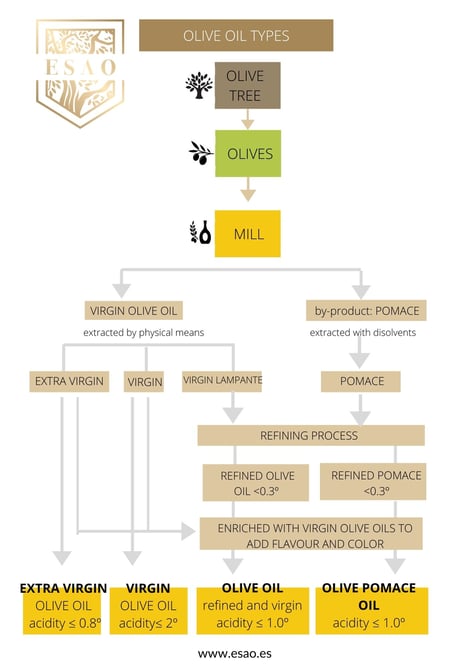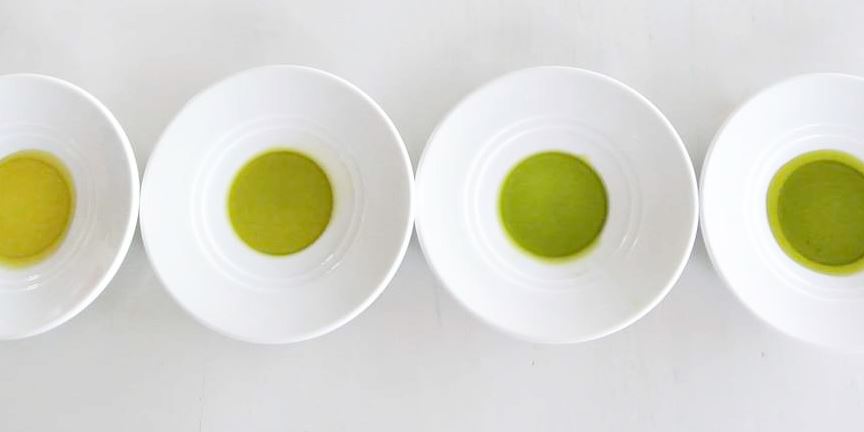Listen to this article
There is a wide range of olive oil types in the market, as well as some confusion on this issue. Being able to taste and know what type of olive oil you have in your hands is the basis for any food aficionado and a good Olive Oil Sommelier.
When tasting and buying olive oil some questions may arise such as:
- What is the difference between a virgin and extra virgin oil?
- What is lampante olive oil?
- What is refined olive oil?
- What is pomace?
We 'll tell you here.
Types of olive oil according to rules
As you may already know, the highest quality olive oil is Extra Virgin Olive Oil (EVOO), considered superior because it is theoretically obtained from the best olives and solely by mechanical means, achieving an oil with excellent organoleptic and valuable benefits to our health.
But not all olive oils approved for human consumption are extra virgin.

There are international regulations on olive oil intended to ensure the quality and transparency in the marketing of different types of olive oil based on the extraction process, the acidity and other parameters obtained by physicochemical analysis at an accredited laboratory.
Furthermore, in the case of higher quality oils, they are also assessed by their organoleptic parameters (smell and taste), by a Taste Panel consisting of skilled and trained olive oil tasters .
Extra virgin olive oil
Extra virgin olive oil is extracted exclusively by mechanical means with a maximum acidity of 0.8%.
This parameter is obtained by a laboratory analysis, and is directly related to the amount of free fatty acids that exist in the oil, which occur mainly because all the olives are not in optimal health, as is common with chopped olives, fermented olives, etc. Thus, the lower the acidity, the higher the quality of the fruit and olive oil produced.
However, the acidity is not the only parameter that is taken into account to determine olive oil quality. There are other parameters such as Peroxides, K232, K270, DeltaK or waxes.
But what do these parameters mean?
- The peroxide value is the amount of active oxygen in the oil and gives us an idea of the degree of oxidation or rancidity (poor taste). Peroxides indicate how deteriorated certain components are, such as antioxidants, polyphenols, or nutritional components such as vitamin e, tocopherols, etc. In the case of extra virgin olive oil, this parameter cannot exceed 20 meq/kg (milliequivalents per kilogram).
- K232 is used to see the presence of hydroperoxides and conjugated dienes. In other words, an estimate of the initial oxidation of the oil is made.
- K270 is used to detect the presence of secondary oxidation products. The products of the initial oxidation evolve to aldehydes, ketones, ... At this wavelength they also absorb products that are formed in the refining of the oils.
High values of K232 and K270 are synonymous with poor quality oils.
- Delta K: This test is used to detect if refined oil has been mixed with virgin olive oils.
- The test for wax is used to detect the presence of “second pressing oil” or “pomace oil” (oil made from leftover olive paste) in virgin and extra virgin olive oil.
Waxes are natural compounds found for the most part in the olive skin and can only be extracted through high energy processes, and therefore they only show up in the leftover oil paste, not in virgin oils.
In short, after a thorough analysis, it is possible to know whether an olive oil extra virgin has been adulterated or defects that may cast doubt on his extra - virgin , as has already demonstrated the OCU controls performed to detect fraud as usual with this product.
Virgin olive oil
Virgin olive oil is lesser grade than extra virgin oil, with free acidity of up to 2.0%, and is judged to have a good taste, but may include some sensory defects.

Lampante olive oil
The Lampante olive oil is the juice (extracted by mechanical methods) resulting from poorer quality olives. Usually the olives that are harvested when they are already too ripe, or already in fermentation.
Lampante virgin oil is not suitable for human consumption without further refining; “lampante” is the attributive form of “lampa”, the latin word for “lamp”, referring to the earlier use of such oil in oil lamps. It was also used in ancient Rome to feed the slaves as a sign of his "generosity".
Lampante virgin oil can be used for industrial purposes, or refined to make it edible.
Refined Olive Oil
This is where we begin to see some confusion among consumers, as there is a commercial category for just "olive oil", sometimes with labeled as soft or intense.
It actually contains a blend of virgin olive oil with refined oils obtained from defective oils (lampante) by chemical or thermal processes with a degree of acidity of 1.5% maximum.
During the refining processes, the acidity and other physicochemical parameters are drastically reduced. However, many healthy properties are also reduced: this type of olive oil has no taste and has lost much of its organic compounds and natural antioxidants present in oils of superior quality.
It is therefore important to understand what are we buying, by reading carefully the labels so as not to be fooled by its marketing.
Remember: olive oil sold to us as "soft" or "intense" olive oil is not a juice. It contains mostly refined olive oils.
Pomace oil
Crude olive pomace oil is the oil obtained by treating olive pomace (the leftover paste after the pressing of olives for virgin olive oils) with solvents or other physical treatments, to the exclusion of oils obtained by re-esterification processes and of any mixture with oils of other kinds. It is then further refined into Refined olive pomace oil and once re-blended with virgin olive oils for taste, is then known as Olive pomace oil.
Pomace oil has a maximum degree of acidity of 1.5% and is suitable for human consumption.

Other types of olive oil
Apart from this basic classification, we can find other subtypes of olive oils, for example depending on the
- variety of olive: Picual, Arbequina, Hojiblanca, etc.
- geographical origin: mountains, countryside, etc.
- time of collection (early harvest, etc.
- oil extraction process: first cold pressed, unfiltered, etc.
We encourage you to continue investigating, searching and tasting. Learn about the diversity of aromas, flavours, colours and sensations and immerse yourself in the world of olive oil, which is both complex and amazing.
.png)


